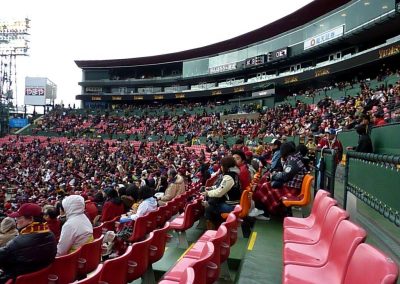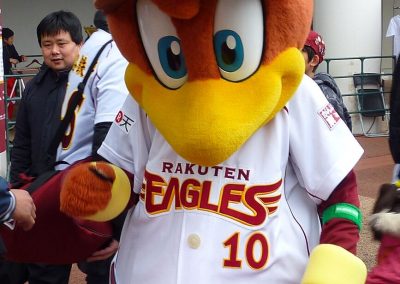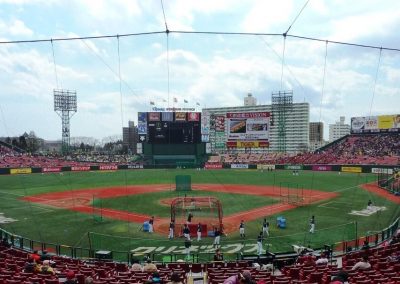Rakuten Mobile Park Miyagi - Tohoku Rakuten Golden Eagles
- Sean MacDonald
- Jun 7, 2013
- 7 min read
Updated: Mar 11, 2023
Photos by Sean MacDonald, Stadium Journey
Stadium Info FANFARE Score: 3.57
Rakuten Mobile Park Miyagi 2-11-6 Miyagino Sendai, Miyagi 983-0045 Japan
Year Opened: 1950 Capacity: 23,000
Nothing to Sneeze At
Note: The stadium has been renamed since this review.
The Tohoku Rakuten Golden Eagles are the newest franchise in Japanese baseball, having been formed in 2005 to fill the void created by the merger of the Kintetsu Buffaloes and Orix Blue Wave. The irony of replacing the Blue Wave is unfortunate as the Eagles are based in Tohoku, which was devastated by the double disasters in March, 2011. The stadium is located in Sendai which sustained heavy damage from the earthquake before the coast was inundated by the subsequent tsunami. Kleenex Stadium was not spared, suffering structural damage that was only completely repaired recently. The team was forced to play home games at other NPB ballparks during the early part of the 2011 season but returned home in late April, where they became a symbol of the rebuilding process and lifted heavy hearts across the region.
Kleenex Stadium Miyagi was opened in 1950 and actually served as the home ground for the Lotte Orions (now the Chiba Lotte Marines) between 1973 and 1977. However, it was very dated when the Eagles were granted a franchise and much renovation was done to modernize it in time for their first game. In fact, when I first went I initially thought it was a new stadium, a testament to the great job done here.
The stadium is currently known as Rakuten Kobo Stadium Miyagi.
Food & Beverage 5
There are dozens of concessions that sit outside the actual stadium and offer everything from hot wine to the local delicacy, gyutan (cow’s tongue). For those without a taste for the unusual, there was even a KFC stand. Gates open two hours before game time, but get there before then because the outside area is far more active and it will take you a while to see everything. Walk around the stadium to see all the culinary possibilities; early arrivers can easily have two meals here. There are even some seating areas where you can grab a table and relax with your lunch or dinner.
The information desk has a great brochure listing all the spots both inside and outside the gates. On the outside, I tried the dim sum box near gate R6 which was pretty average, 3 pieces for 350 yen. My recommendation on the inside of the ballpark is the steak bowl on level 3. It is crowded and takes a while to get the food, but was good value for the price at 650 yen.
The Eagles Nest Sports Lounge was very popular, likely for providing some indoor warmth on this chilly April afternoon, and had some tempting options as well.
Beer here is available everywhere, including the ubiquitous beer girls that roam through the aisles. Always choose this option as you don’t have to leave your seat. I did notice prices here were slightly cheaper than Tokyo, with a draft going for 700 yen.
Atmosphere 3
With fewer than 19,000 showing up (out of a capacity of 23,000) and the weather still in the throes of winter’s last hurrah, there wasn’t a whole lot of fun being had. The home team struggled against a star rookie pitcher and there wasn’t a lot of fan activity during the game, other than the typical outfield cheering sections.
Having so much of the food and drink options outside the main stand also keeps fans coming and going and makes it difficult to establish a true baseball atmosphere.
The Eagles do have a very active cheer squad known as the Angels consisting of about 16 young ladies who dance on the field during the game and bring a bit of pep to the proceedings. Beforehand they have a couple of shows on a stage located near gate R2, where you can also find the usual hordes of perverts with their zoom lenses.
Neighborhood 2
The stadium is located about 20 minutes by foot from the main train station. Unfortunately, there is little to see on this walk, with few, if any, restaurants or bars. It’s mostly a business area that is rather devoid of business on a Sunday afternoon.
Sendai Station is where the action is, but even then it is rather muted compared to some other Japanese cities. Most of the restaurants in the area are serving cow’s tongue as all Japanese tourists must eat this while visiting Sendai. The locals tell me they don’t eat it that often, and having tried it a few times myself, I would agree with them. The west side of the station had a few izakayas but in general, central Sendai is one of Japan’s quieter urban areas.
Fans 4
Rakuten fans have developed into decent supporters, although they were soundly outclassed by the visiting Chiba fans on this day. To be fair, their team is off to a poor start and the weather was not pleasant in the least, so I’m going to recall an earlier visit where they stayed to the end of a 4 hour 20 minute game (9 innings!) cheering their boys on to an amazing comeback victory.
Despite their relatively few numbers, the Lucky 7 balloon time was very impressive, with nearly all of the fans participating. In Japan, supporters of both teams sing the team song and get to release colorful balloons after their team finishes batting in the 7th inning. It makes for interesting visuals as you can see in a couple of pictures in the photo gallery.
Access 3
As mentioned, the stadium is a 20-minute walk from the main train station, or you can take the Senseki Line from there to Miyaginohara station, which is known as “Baseball Station” due to its proximity to the ballpark. From there, it is just a 5-minute stroll to the stadium, which lies next to a track and field facility.
I bought a field level seat from where the view was poor, so I moved to a better location after a few innings. The field level seats have their own gate and no concessions as well as no other way to access the rest of the stadium. Fortunately, you can move back and forth between the main stand and the field seats as long as you tell them that you are going to get some food. Once I found a seat I liked, I planted myself down. A few innings later, a staff member inquired about my ticket and I said I didn’t have one for this area. She said that’s fine, but please move if the seat holder returns.
Well duh!
Getting around the main part of the stadium is a pain. The walkway has two gates that force you to go up some stairs and back down on the other side, an unnecessary 30-second detour. These gates are easily moved and vendors are constantly passing through them, so it makes no sense that fans can’t have the same access.
The inner concourses are quite small, particularly the third floor which is heavily crowded before the game as fans line up for food. Capacity here is 23,000, about half that of the Tokyo Dome, but it certainly seems much more busy with the small floor space.
This stadium is over 50 years old, but the renovations have taken care of many of the problems that bedevil aging facilities. However, increasing concourse space is something that would take away seating, and I don’t think they will be doing that in the near future. Try to tour the stadium early, before the crowds arrive.
Return on Investment 3
Tickets here vary widely in price as Rakuten has adopted the variable pricing method, with five categories of games, ranging from Platinum down to Value, with Gold, Silver, and Bronze rounding out the list. The most expensive ticket is called a Golden Seat (yet again with the metals) and costs 7,700 yen for the Platinum games and only 3,100 yen for the Value games. So go to the Value games if you can. There are 18 different seating options, so the ticket matrix lists 90 possibilities, which I will not detail here. My advice is to sit in the infield A seats or upper level seats on the 3rd base side (unlike most Japanese stadiums, the home team uses the 3rd base dugout). One good thing about Kleenex Stadium is that the screen doesn’t extend all the way down the lines so if you are sitting high enough, you can have an unobstructed view of the field from these seats.
There are two scoreboards: the main one is the typical Japanese one with lineups and the linescore, but there is also a video screen that shows detailed stats as the game progresses. Definitely something I’d like to see at other parks.
Extras 5
Fans arrive early to participate in many special giveaways. I noticed at least 3 long lines, each one for a different promotion. Often one needs to be a member of a fan club or have a special type of ticket to participate. There is always a guy holding a sign indicating the end of the queue so if you are not sure, you can ask him what the line is for.
The mascots tour around the stadium before the game signing autographs for the kids. There is also a small train which takes young children around the stadium along with their bemused parents.
You can also find a home plate and bases buried beneath thick plastic windows; there doesn’t seem to be any meaning behind them and the windows were covered with condensation so I couldn’t read the plaque inside.
Some fans who won a contest are allowed on the field before the game to play catch, and all fans are invited on the field afterwards, although you have to wait 30 minutes after the game finishes.
Just before the game starts, an eagle flies in from beyond the outfield fence to first base; a majestic sight that is somewhat ironic given the team rarely soars into the playoffs (only two appearances in nine seasons).
Final Thoughts
When I first visited here in 2005, I thought it was the best ballpark in Japan, but upon reflection, I think I overstated things then. The food selection is great and there are lots of cool things around, but the location is not that good and once inside, moving around is a hassle. Even with these problems though, it is better than the average domed stadium and certainly worth a trip to Sendai to see the Golden Eagles.
**Follow all of Sean’s journeys at Sports Road Trips.












Comentarios